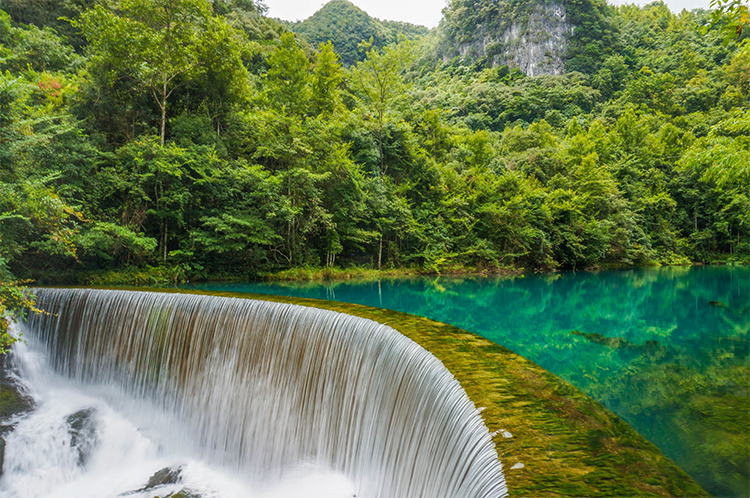Explore Xiaoqikong Water Forest: Guizhou’s Emerald Karst Park
Xiaoqikong: Guizhou’s Emerald Karst Park
Introduction**
When the seven-arch ancient bridge is mirrored across an emerald river and the roar of the 68-level waterfall echoes through primeval forest, you understand why Xiaoqikong is called the “emerald on the Earth’s belt.” Tucked into the karst mountains of Libo County, Guizhou, Xiaoqikong weaves rivers, waterfalls, stone bridges, and forests into a living ink-and-wash landscape. Recommended by Lonely Planet as one of China’s top hidden hiking gems and protected as part of the South China Karst UNESCO site, this is a rare ecological treasure.
1. World Heritage-level Karst Wonder: Millennia of Water and Stone
The soul of Xiaoqikong begins with the seven-arch ancient bridge built across the Xiangshui River in 1835. This Qing-era stone bridge not only gives the park its name but also connects generations of Buyei villages. Beneath it the water is crystal clear, shifting between blue and green under changing light, creating a striking contrast with the jagged karst peaks.
As the core area of the South China Karst World Heritage, Xiaoqikong concentrates 200 million years of geological evolution:
– Water Forests: A rare karst phenomenon where mature tree roots grow directly in flowing river channels, creating the surreal scene of trees rising from water and water flowing over stone.
– 68-level Waterfall: Over 1.6 kilometers, 68 cascading tiers form a natural stairway—one of the most spectacular karst waterfall systems.
– Wolong Pool: A gem-like pool fed by an underground river, ringed by an arcing waterfall—an irresistible subject for photographers.

2. The Seasonal Water-and-Mountain Theater: When Is Xiaoqikong Most Beautiful?
Best season: April–October (summer for fullest waterfalls; autumn for colorful foliage)
– Spring (Mar–May): Wildflowers dot the slopes and waterfalls run moderately—ideal for relaxed hiking.
– High Summer (Jun–Aug): Water volume peaks; the 68-level waterfall roars like galloping horses. The water forest becomes a playful wading area (bring water shoes).
– Golden Autumn (Sep–Oct): Red and gold leaves set off the clear pools; morning mist often drifts over Wolong Pool, creating a fairy-tale scene.
– Winter (Nov–Feb): Fewer visitors; parts of the waterfall freeze into crystalline icicles, though some trails may close.
Golden moments:
– Within 12 hours after heavy rain: Waterfalls reach maximum flow and may create double rainbows at Raya Waterfall.
– Early morning (7–9am): Wolong Pool fills with mist before tour groups arrive—best for quiet photography.

3. Deep-dive Practical Guide: From Hikes to Local Culture
3.1 Classic One-day Route (reverse flow to save energy)
West Gate → Wolong Pool → Mandarine Duck Lake (boat) → Cuigu Waterfall → Water Forest → 68-level Waterfall → Seven-arch Ancient Bridge → East Gate (approx. 5–6 hours, includes electric shuttle segments)
3.2 Must-do Experiences
– Mandarine Duck Lake Boat Ride: Self-row through maze-like water-forest channels (30 RMB/person, 1 hour).
– Raya Waterfall Shower: Stand on the platform beneath the falls and feel the negative-ion spray.
– Buyei Long-table Banquet: In Yao Mountain Township outside the park taste sour fish and five-color glutinous rice (about 50 RMB per person).
3.3 Who Should Visit?
– Families: Electric shuttles link key sites and shallow water banks are child-friendly.
– Photographers: Bring a polarizing filter for reflections; drones require prior approval.
– Hikers and adventurers: Boardwalks along the 68-level falls and trails through virgin forest offer real exploration.
4. Practical Information: Plan with Ease
Transport:
– From Guiyang: 3.5 hours by car (highway access), or take the Guiyang–Libo coach (about 4 hours) then transfer to the park shuttle.
– High-speed rail option: Gui–Nan high-speed line now serves Libo Station; a 30-minute tourist shuttle connects the station to the park.
Tickets & Opening Hours:
– Peak (Mar–Nov): 170 RMB (includes sightseeing shuttle) | Off-season (Dec–Feb): 110 RMB
– Opening hours: 07:30–16:30 (last entry 16:00)
– Tip: Reserve in advance via the “One QR Code Travel Guizhou” app; weekend daily caps may limit visitors to 12,000.
Accommodation:
– Upscale: Xiaoqikong Ruijing Hotel—only on-site hotel with windows facing the pool.
– Budget/value: Mengliu Buyei-style guesthouses—10-minute walk to East Gate, excellent local food and atmosphere.

Final tips:
Enter with the first group at dawn to enjoy the bridge reflections and the hush before crowds arrive. Carry a waterproof pouch—wading the water forest (knee-deep in places) is the most immersive way to step into this landscape. When you touch the smooth stone rail of the seven-arch bridge or hear a Buyei girl sing a mountain song, you’ll understand why Xiaoqikong leaves an emerald mark on the heart.


